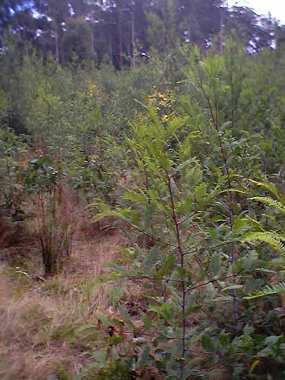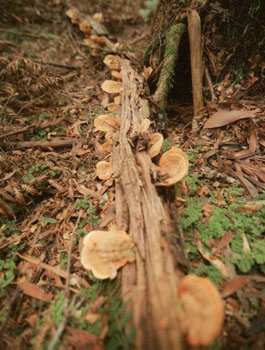
Impacts of Clearfell Logging on biodiversity
Myth that native forests "regenerate" after clearfell logging.
The concept that forests 'regenerate' after logging, is widely used by spokes people for the native forest logging industry. The use of the word 'regenerate', implies a forest will eventually return to its original state after logging has finished. This has the effect of deceiving the public into believing nothing is being lost.A eucalypt forest can have a life cycle of between 250 and 400 years depending on the species and fire frequency Link. Research shows the average fire frequency in wet forests before European settlement was once every 300 years or greater. See ref 4.
Government practice is to clearfell log in 60 to 80 year cycles. The claim that government bureaucrats can 'regenerate' a 300 + year biodiverse native forest in just 60-80 years is stuff of magicians!
|
Additionally, what regrows on a site after a forest is clearfell logged is not the same mix of trees that were growing before clearfell logging. Often a crop of wattle trees regrows in areas that were clearfell logged. This virtual monoculture is something even the logging industry does not want. It certainly isn't a regenerated forest, and is unlikely to be.
Photo to the right shows wattle trees that have re-grown on a site that was biodiverse native forest before it was clearfell logged. |
 |
Myth that clearfell logging mimics natural wildfire regeneration
The concept that 'burning an area of forest after clearfell logged mimics nature' is widely used by spokes people for the native forest logging industry. This statement ignores:
- the damage done by bulldozers on understorey species;
- the impact of total tree removal on ecology ie the loss of hollow bearing trees;
- the impact of road construction, snig tracks and log landings on the natural landscape;
Burning areas after they have been clearfell logged results in even aged stands of trees that will be never allowed to mature into old growth forest with hollow bearing trees for wildlife to live in.
Research in wet forests of the Central High lands demonstrates that there is a severe decline in the survival rate of tree ferns after clearfell logging. See Ref 5.
Extensive Scientific Research has consistently shown that clearfell logging does not mimic the natural effect of wild fire. The native forest logging industry never cites any scientific papers to back up their claim. However many research papers demonstrate clearfell logging does not mimic natural fire processes.
Ash Forest and Fire
Forestry officers apply a generic model of fire regeneration for all types of forest based on ash species response to an intense fire event. It has been observed that in some instances, an intense hot bushfire in ash forest can completely killed off all trees and result in an even age regrowth forest. However such a scenario ignores low intensity fires which result in mixed aged ash forests, with only some ash trees dying. Link Extract
Mountain Mixed Species and Fire
Forest types such as mountain mixed species eucalypt forest types can survive both high and low intensity fires. After fire, trees coppice and quickly grow new foliage. The new foliage provides shade and protection for understorey species such as tree ferns(which can survive fire) in a relatively short time(few years). See Impacts of intensive timber harvesting on the forests of East Gippsland, Victoria. Ref 1
Extract
Floristics, Fire and Clearfelling in Wet Forests
of the Central Highlands, Victoria
VSP Technical Report No. 11
Discussion
Even-aged regeneration resulting from wildfire which kills all parent trees formerly considered to be characteristic of tall eucalypt forests. Most authors considered Eucalyptus regnans (Mountain Ash) and Eucalyptus delegatensis to be so fire sensitive that wild fire resulted in regeneration predominantly as even-aged stands. (e.g. Cunningham 1960, Ashton 1976, Luke & Macarthur 1978).
However, this study supports more recent evidence (e.g. Ashton 1981, Chesterfield 1983, Bowman & Kirkpatrick 1986, Lindenmayer 1990) that low intensity fires have resulted in extensive ares of mixed aged regnans forest. At least 38% of the wet sclerophyll forest sites sampled in this study (excluding clearfell sites) are mixed aged forests that appear to have developed this way. Current clearfelling methods produce even-aged overstoreys. The prevalence of this natural heterogeneity needs to be considered when planning new silvicultural systems and forest management.
The myth woodchips are produced from waste wood.
Over 80% of all trees that are cut down in the Otways are classed as "waste wood" by Forestry Victoria. Spokespeople for the native forest logging industry argue that if this wood is not utilised for woodchip then it will be left to rot or be burnt on the on the forest floor. They argue that letting dead trees rot is a waste.
|
There is no such thing as waste in the ecology of the forest. Over millions of years of evolution, thousands of species of fungi have evolved in the Otway forests to break down wood and recycle nutrients back into the ecosystem. It can take fungi a human life time to decay a huge mountain ash tree after it naturally falls over. Nothing in the forest is wasted, all the wood is returned back to soil by fungi for the next generate of plants to use. (For more information see The Private Life of Plants. David Attenborough, TV Documentary) The very concept of using the word 'waste' or 'residual' reduces the debate to a singular human economic perspective. Removing wood for woodchips removes valuable nutrients and over time this will decrease the fertility of the soil. |
 Funghi break down fallen trees and branches, making the nutrients available to growing plants. |
Additionally trees left standing are not 'wasted' on birds and animals that depend on them for survival. Put another way, the general public doesn't view a National Park or forest reserve as a waste because it is not being utilised for woodchips.
References
1. Impacts of intensive timber harvesting on the forests of East Gippsland, Victoria. Conservation & Natural Resources, VSP Technical Report No. 15. S.G. Mueck & R.J. Peacock
2. Differences between wildfire and clearfelling on the structure of montane ash forest of Victoria and their implications for fauna dependent on tree hollows. (D.B. Lindenmayer, TW Norton, Aust For. 1990, 53 (2) 61-68
3. Floristics, Fire and Clearfell in Wet Forests of the Central Highlands, Victoria. Dept. Conservation and Environment July 1992, Flora and Fauna Dept, VSP Technical Report No. 11
4. The response of vegetation to changing fire regimes and human activity in East Gippsland, Victoria, Australia. Department of Geography and Environmental Science, Monash University. Peter A. Gell, Ian-Malcolm Stuart and J. David Smith
5. The effects of clearfell logging on tree ferns in Victoria Wet Forest. DNRE Flora and Fauna branch. Nov 1996
Relevant Links
Don't know the meaning of a word? Check the glossary.